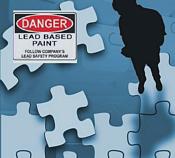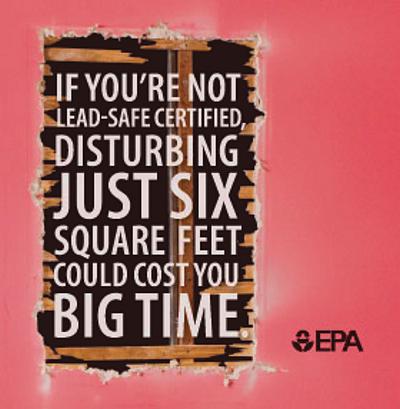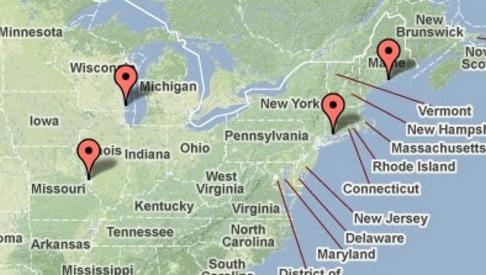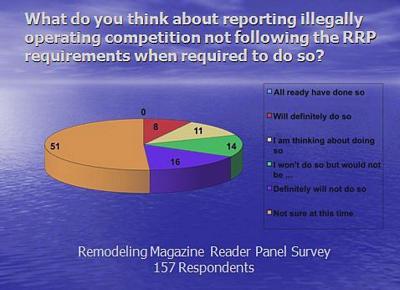EPA Announces More Lead Paint Violation Fines; This Time Against Landlords
Seems EPA has started their publicity campaign regarding enforcement of RRP and other lead related regulations. This one is not RRP specific, but as the second violation announcement this week it certainly seems to demonstrate that EPA is using enforcement and press releases to get their message out about compliance with lead paint requirements.
News Release
U.S. Environmental Protection Agency
New England Regional Office
April 11, 2012
Contact: Paula Ballentine, 617-918-1027
Conn. And Mass. Based Landlords Face Fines for Failing to Notify Tenants about Lead Paint
(Boston, Mass. – April 11, 2012) The owners of rental properties in Bridgeport, Conn. as well as South Boston, Roxbury, and Dorchester, Mass., face EPA penalties for violating federal lead paint disclosure rules. In both cases, these violations potentially put tenants at risk of exposure to lead hazards.
According to a complaint filed by EPA’s New England office, Juan Hernandez allegedly violated lead-based paint disclosure requirements seven times when he rented apartment units in Bridgeport, Conn. between 2008 and 2010. Mr. Hernandez faces an EPA penalty of up to $127,150 for violating federal lead paint disclosure rules. During the time period relevant to EPA’s investigation, all of the apartment buildings owned by Mr. Hernandez were located in potential environmental justice areas.
In a separate EPA complaint, Edward Franco, owner of El Paso Management, and its affiliates allegedly violated lead-based paint disclosure requirements when they rented apartment units three times in South Boston, Roxbury, and Dorchester in 2009. Most of the tenants involved in this case live in low income and/or minority areas.
Both parties are charged with failing to give tenants required lead hazard information pamphlets, failing to include lead warning statements in leases, failing to disclose any known lead-based paint or lead-based paint hazards, and/or failing to provide records or reports pertaining to lead-based paint or lead-based paint hazards.
Federal lead disclosure rules are meant to give tenants adequate information about the risks associated with lead paint so that they can make informed decisions before signing a lease contract. Property owners leasing housing built before 1978 are required to provide the following information to tenants: the EPA-approved lead hazard information pamphlet, Protect Your Family from Lead in Your Home; a lead warning statement; statements disclosing any known lead-based paint and/or lead-based paint hazards; and copies of all available records or reports regarding lead-based paint and lead-based paint hazards. This information must be provided to tenants before they enter into leases.
Infants and young children are especially vulnerable to lead paint exposure, which can cause developmental impairment, reading and learning disabilities, impaired hearing, reduced attention span, hyperactivity and behavioral problems. Adults with high lead levels can suffer difficulties during pregnancy, high blood pressure, nerve disorders, memory problems and muscle and joint pain.
More information:
Lead-based paint health hazards (www.epa.gov/ne/eco/ne_lead/index.html)
Lead-based paint disclosure rule (www.epa.gov/ne/enforcement/leadpaint/index.html)
Click here for more RRPedia blog posts for landlords.
Shawn is available to help landlords with the RRP Rule. If you are a landlord or belong to a landlord association that is seeking assistance with the RRP rule, contact Shawn today to discuss how he can help.

 Looking for accurate information about the EPA RRP rule?
Looking for accurate information about the EPA RRP rule? 


 In reality what they have done has not been effective. Either the message is not effective, the placement is not effective or both. According to a
In reality what they have done has not been effective. Either the message is not effective, the placement is not effective or both. According to a 

 So far EPA has only published one violation since the rule came into effect in April of 2010. On the other hand the state of Massachusetts took over the rule in July of 2012 and has
So far EPA has only published one violation since the rule came into effect in April of 2010. On the other hand the state of Massachusetts took over the rule in July of 2012 and has  It is a fact that lead is poisonous and RRP activities can cause poisoning. However, EPA does not know how many children were actually poisoned by RRP activities before the rule came into effect. If you check any of the data it refers to RRP activities as the “likely source” of lead poisoning, not “the cause”. That being the case, EPA has no way to know if the RRP rule is making a difference or not. It is ‘likely” that it is helping. But, without knowing where EPA started and where we are now that the rule has been in place for almost a year, EPA has no idea if what they have been doing is effective enough and or if or where it can improve effectiveness within the rule.
It is a fact that lead is poisonous and RRP activities can cause poisoning. However, EPA does not know how many children were actually poisoned by RRP activities before the rule came into effect. If you check any of the data it refers to RRP activities as the “likely source” of lead poisoning, not “the cause”. That being the case, EPA has no way to know if the RRP rule is making a difference or not. It is ‘likely” that it is helping. But, without knowing where EPA started and where we are now that the rule has been in place for almost a year, EPA has no idea if what they have been doing is effective enough and or if or where it can improve effectiveness within the rule.  A recent example of this related to lead in construction is discussed in an
A recent example of this related to lead in construction is discussed in an  At the San Juan National Historic Site project eight alleged serious violations resulted from a lack of medical evaluations and fit-testing for employees using respirators, improper storage of compressed gas cylinders, no eye-wash stations where employees worked with corrosive products, an uncovered electrical receptacle, a lack of hazard communication training and material data sheets of the products used, and not implementing hazard communication and written respiratory protection programs.
At the San Juan National Historic Site project eight alleged serious violations resulted from a lack of medical evaluations and fit-testing for employees using respirators, improper storage of compressed gas cylinders, no eye-wash stations where employees worked with corrosive products, an uncovered electrical receptacle, a lack of hazard communication training and material data sheets of the products used, and not implementing hazard communication and written respiratory protection programs. “There is a new sheriff in town. Make no mistake about it; the Department of Labor is back in the enforcement business… Under my watch, enforcement of labor laws will be intensified to provide an effective deterrent to employers who put their workers’ lives at risk.”
“There is a new sheriff in town. Make no mistake about it; the Department of Labor is back in the enforcement business… Under my watch, enforcement of labor laws will be intensified to provide an effective deterrent to employers who put their workers’ lives at risk.” The press release below explains how the violator was investigated after a YouTube video of the the renovator's workers in action was posted showing the total lack of lead-safe work practices in place as the workers used power equipment to remove paint on a rental property on Rockland ME.
The press release below explains how the violator was investigated after a YouTube video of the the renovator's workers in action was posted showing the total lack of lead-safe work practices in place as the workers used power equipment to remove paint on a rental property on Rockland ME.  Will this be the first of many press releases by EPA regarding enforcement? Many contractors who have complied with the RRP rule hope so. According to Curt Spalding, regional administrator of EPA’s New England office: "Enforcement of these rules is important to protecting children and the business interests of those contractors who are following the rules.”
Will this be the first of many press releases by EPA regarding enforcement? Many contractors who have complied with the RRP rule hope so. According to Curt Spalding, regional administrator of EPA’s New England office: "Enforcement of these rules is important to protecting children and the business interests of those contractors who are following the rules.” 

 In my opinion this tool will be helpful for those renovators following RRP requirements for a variety of reasons. For example, it will help level the playing field for legally operating businesses if the awareness of audits persuades illegal businesses to change their ways. Because the tool allows those reporting audits to include details about the audit, renovators will learn what to expect and how to better handle an audit if one happens to them. Also, for those who like to help their peers, being able to submit a report that is informative and shares constructive advice becomes a win-win for both the reporter and those who read the reports.
In my opinion this tool will be helpful for those renovators following RRP requirements for a variety of reasons. For example, it will help level the playing field for legally operating businesses if the awareness of audits persuades illegal businesses to change their ways. Because the tool allows those reporting audits to include details about the audit, renovators will learn what to expect and how to better handle an audit if one happens to them. Also, for those who like to help their peers, being able to submit a report that is informative and shares constructive advice becomes a win-win for both the reporter and those who read the reports. On the other hand, the tool will not likely be helpful to those who knowingly and willfully violate the rule. Knowing where EPA, OSHA and/or states agencies are doing inspections or audits won’t be much help in hiding from an inspector. As we have seen, job site inspections are not likely. Removing magnetic signs or parking their trucks out of view won’t protect violators from an audit. The required documentation gives the authorities the ability to retroactively inspect work practices as well as compliance with owner and occupant pre-notification requirements. Because the EPA rule dictates that all required documentation be kept for three years, one visit to a renovator’s office by EPA can uncover enough violations and justify enough fines to put an illegal business out of business. The Massachusetts requirement for storing documents is 10 years, giving illegal businesses in that state much more to be worried about.
On the other hand, the tool will not likely be helpful to those who knowingly and willfully violate the rule. Knowing where EPA, OSHA and/or states agencies are doing inspections or audits won’t be much help in hiding from an inspector. As we have seen, job site inspections are not likely. Removing magnetic signs or parking their trucks out of view won’t protect violators from an audit. The required documentation gives the authorities the ability to retroactively inspect work practices as well as compliance with owner and occupant pre-notification requirements. Because the EPA rule dictates that all required documentation be kept for three years, one visit to a renovator’s office by EPA can uncover enough violations and justify enough fines to put an illegal business out of business. The Massachusetts requirement for storing documents is 10 years, giving illegal businesses in that state much more to be worried about.
 According to an
According to an  The following is News Release from EPA, published on February 8, 2011. Though not specific to the RRP Rule, this action by both EPA and the FBI shows that willfull violators of lead related regulations are currently a major focus for EPA and they are serious about prosecuting violators.
The following is News Release from EPA, published on February 8, 2011. Though not specific to the RRP Rule, this action by both EPA and the FBI shows that willfull violators of lead related regulations are currently a major focus for EPA and they are serious about prosecuting violators. 
 Although every “legal” remodeler I have spoken to expresses concerns about illegal competition doing their work in violation of the RRP rule, these remodelers are split about whether to report their illegal completion or not. At the Opening Session I presented on Thursday morning at the Remodeling Show I offered my point of view on this. I suggested that illegal contractors and the home owners who hire them are stealing business and money away from legal remodelers and their employees. I gave the example that if you or I steal a TV from someone and get caught, we must return the TV and suffer any consequences. If an illegal contractor or home owner steals a deck job from a legal contractor little or nothing is ever done and the home owner gets to keep the deck. How long will our industry and the trade associations that represent us tolerate this? Just like with illegal immigration, because our government does not enforce existing rules and laws on a consistent basis, illegal contractors operate with little fear of being caught and even if caught, have little fear of any consequences.
Although every “legal” remodeler I have spoken to expresses concerns about illegal competition doing their work in violation of the RRP rule, these remodelers are split about whether to report their illegal completion or not. At the Opening Session I presented on Thursday morning at the Remodeling Show I offered my point of view on this. I suggested that illegal contractors and the home owners who hire them are stealing business and money away from legal remodelers and their employees. I gave the example that if you or I steal a TV from someone and get caught, we must return the TV and suffer any consequences. If an illegal contractor or home owner steals a deck job from a legal contractor little or nothing is ever done and the home owner gets to keep the deck. How long will our industry and the trade associations that represent us tolerate this? Just like with illegal immigration, because our government does not enforce existing rules and laws on a consistent basis, illegal contractors operate with little fear of being caught and even if caught, have little fear of any consequences.
 As we all wait to see what happens with the economy and how long a real recovery will take, I predict that their ability to pay their mortgage and put food on the family table will persuade many remodeling business owners to take action and defend their ability to run honest businesses.
As we all wait to see what happens with the economy and how long a real recovery will take, I predict that their ability to pay their mortgage and put food on the family table will persuade many remodeling business owners to take action and defend their ability to run honest businesses.



